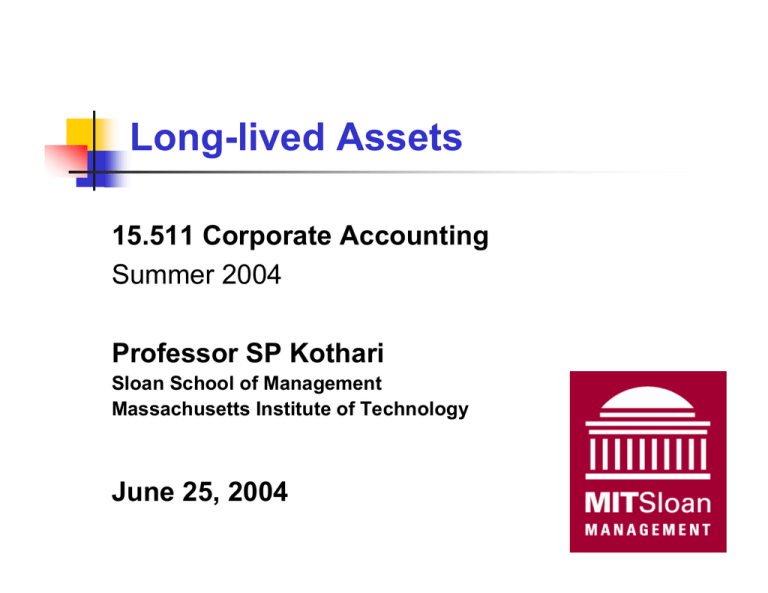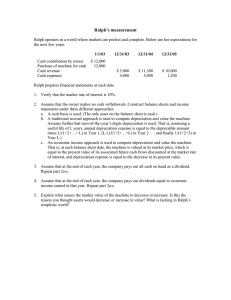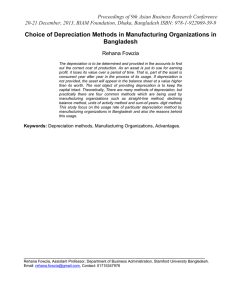Long-lived Assets 15.511 Corporate Accounting Professor SP Kothari June 25, 2004
advertisement

Long-lived Assets 15.511 Corporate Accounting Summer 2004 Professor SP Kothari Sloan School of Management Massachusetts Institute of Technology June 25, 2004 1 Agenda Understand how the matching principle influences the capitalization of long-lived assets the expensing of capitalized costs to match revenues generated in the use of long-lived assets Understand how differences in “book” vs. tax accounting for depreciation lead to deferred taxes 2 Review of Matching Principle Capitalize versus Expense Capitalized Costs means show it as an Asset on the Balance Sheet Expense (i.e., not capitalize) when Assets have future benefits benefits are immediate OR future benefits are too uncertain or immaterial (e.g., R&D) Assets are consumed (in future) to generate future revenues Current Assets like Inventory, Prepaid Rent, and Insurance Non-current assets like Plant, buildings, machinery NC Intangible assets like Patents, acquired goodwill 3 The case of non-current assets: PP&E Accounting for Non-Current assets: What is the acquisition cost? What is the expected useful service life? What is the salvage value? What pattern of depreciation should be used to allocate expense over the useful life? Note: Land is the only non-current asset that is never depreciated / amortized 4 Determining Acquisition Cost What is given up to obtain the asset? Purchased Assets: Purchase price plus cost to prepare the asset for use (installation, transport) Include all costs required to bring the asset into serviceable or usable condition and location. Case 1: Cash Case 2: Financing (down payment plus loan/note) Self-Constructed Assets Direct costs of construction Financing costs (interest on funds borrowed to finance construction) 5 Determining the Acquisition Cost Purchased Assets: Example 1 ABC, Inc. purchases new equipment on 1/1/03. The firm pays $890,000 to the vendor of the machine pays $51,000 to transport the equipment pays $8,000 for insurance during transportation estimates that maintenance will cost $4,000 in the first year, and will rise by about 20% annually for 10 years What is the balance sheet effect on 1/1/03? Asset, Equipment = $949,000 (= 890 + 51 + 8) 6 Determining the Acquisition Cost Purchased Assets: Example 2 Seattle Manufacturing acquires a workstation on 1/1/01. The firm pays a $30,000 down payment to the vendor signs a 3-year note payable for $170,000 at an annual interest rate of 10% pays employees $4,000 to configure the workstation for daily operations and run appropriate tests spends $11,500 to train the employees who will operate the work-station What is the balance sheet effect on 1/1/01? Asset, Work station = $204,000 (= 30 + 170 + 4) 7 Determining the Acquisition Cost Self-constructed Assets: Example Conglomerated Products is constructing a new production facility. Expected completion date is 6/1/2001. During 2000, the company spends $1.7 million for materials pays $2.1 million to architects and laborers accrues interest payable equal to 10% of a $1.6 million construction loan incurs fees related to zoning, inspection, etc. of $52,000 What is the balance sheet effect as of 12/31/00? Asset, Factory building construction in progress = $4,012,000 (= 1,700 + 2,100 + 160 + 52) 8 Salvage Value and Useful Life Determining Salvage Value Determining Useful life Requires managerial judgment SV = estimated proceeds at disposal, net of selling costs What factors can affect this estimate? Depreciable basis = Acquisition cost - SV Requires managerial judgment The time period over which the asset will be used What factors can affect the estimate? Choose depreciation method What does GAAP allow? 9 GAAP Depreciation Methods Production (Use) Method Depreciation cost per machine-hour = depreciable basis/service life (in machine-hours) Depr. Expense = Actual hours used * hourly rate Example: A machine with depreciable basis of $50,000 is expected to provide 20,000 hours of service. During Year 1, the machine is used for 2,500 hours. What is the depreciation expense for Year 1? $2,500*[50,000/20,000] = $6,250 What is the machine’s book value at the end of Year 1? $50,000 - $6,250 = $43,750 10 GAAP Depreciation Methods Straight-line Depreciation Annual Depreciation Expense = depreciable basis/service life (in years) = (AC - SV) / Years Used by an overwhelming majority of US firms Example: Avis acquires cars for its rental fleet for $30,000 each. It expects to rent each car for 2 years, then sell them for $15,000 each. What is the depreciation expense per car for Year 1? ($30,000 - $15,000)/2 = $7,500 What is each car’s book value at the end of Year 1? 11 $22,500 Depreciation Bookkeeping At the time of acquisition of the asset: Dr PP&E 30,000 Cr Cash 30,000 Say SV = 15,000 Depreciable basis = (30,000 – 15,000) Depreciation = (Depreciable basis)/(useful life) = 15,000/2 = 7,500 Dr Depreciation Expense 7,500 Cr Accumulated Depreciation 7,500 12 Depreciation Bookkeeping At the beginning of first year PP&E At the end of first year Gross PP&E Less: Acc Deprecn. Net PP&E 30,000 Income effect 30,000 07,500 22,500 -07,500 At the end of first year Acc. Deprecn. Deprecn. Expense (RE) PP&E 30,000 7,500 7,500 13 GAAP Depreciation Methods Accelerated Depreciation Mostly confined to tax reporting Higher depreciation expense is recognized in the earlier years of an asset’s useful life Differences between Tax depreciation deductions and Financial Reporting depreciation expense give rise to Deferred Tax accounts More on this at end of lecture 14 Depreciation Bookkeeping What accounts does depreciation affect? Accumulated depreciation account, contraasset account Retained earnings account, depreciation expense Which financial statements are affected? Balance sheet and income statement Does depreciation affect cash? No 15






